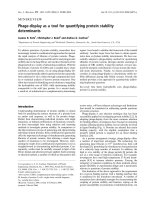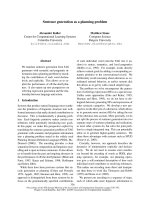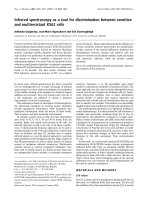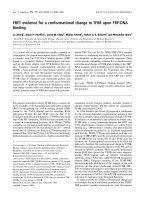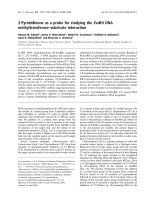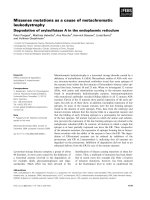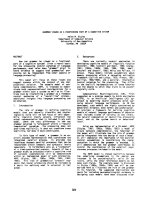Báo cáo khoa học: "Mid-regional pro-adrenomedullin as a prognostic marker in sepsis: an observational study" pot
Bạn đang xem bản rút gọn của tài liệu. Xem và tải ngay bản đầy đủ của tài liệu tại đây (401.12 KB, 9 trang )
Open Access
Available online />R816
Vol 9 No 6
Research
Mid-regional pro-adrenomedullin as a prognostic marker in
sepsis: an observational study
Mirjam Christ-Crain
1
, Nils G Morgenthaler
2
, Joachim Struck
3
, Stephan Harbarth
4
,
Andreas Bergmann
5
and Beat Müller
6
1
Department of Internal Medicine, University Hospital Basel, Petersgraben 4, 4031 Basel, Switzerland
2
Research Department, Brahms AG, Hennigsdorf/Berlin, Neuendorfstrasse 25, 16761 Hennigsdorf, Germany
3
Research Department, Brahms AG, Hennigsdorf/Berlin, Neuendorfstrasse 25, 16761 Hennigsdorf, Germany
4
Division of Hospital Epidemiology, University Hospital Geneva, 24, rue Micheli-du-Crest, 1211 Geneva 14, Switzerland
5
Research Department, Brahms AG, Hennigsdorf/Berlin, Neuendorfstrasse 25, 16761 Hennigsdorf, Germany
6
Department of Internal Medicine, University Hospital Basel, Petersgraben 4, 4031 Basel, Switzerland
Corresponding author: Beat Müller,
Received: 10 May 2005 Revisions requested: 13 Jun 2005 Revisions received: 22 Sep 2005 Accepted: 29 Sep 2005 Published: 15 Nov 2005
Critical Care 2005, 9:R816-R824 (DOI 10.1186/cc3885)
This article is online at: />© 2005 Christ-Crain et al.; licensee BioMed Central Ltd.
This is an open access article distributed under the terms of the Creative Commons Attribution License ( />),
which permits unrestricted use, distribution, and reproduction in any medium, provided the original work is properly cited.
Abstract
Introduction Measurement of biomarkers is a potential
approach to early assessment and prediction of mortality in
patients with sepsis. The aim of the present study was to
evaluate the prognostic value of mid-regional pro-
adrenomedullin (MR-proADM) levels in a cohort of medical
intensive care patients and to compare it with other biomarkers
and physiological scores.
Method We evaluated blood samples from 101 consecutive
critically ill patients admitted to the intensive care unit and from
160 age-matched healthy control individuals. The patients had
initially been enrolled in a prospective observational study
investigating the prognostic value of endocrine dysfunction in
critically ill patients ("PEDCRIP" Study). The prognostic value of
MR-proADM levels was compared with those of two
physiological scores and of various biomarkers (for example C-
reactive Protein, IL-6, procalcitonin). MR-proADM was
measured in EDTA plasma from all patients using a new
sandwich immunoassay.
Results On admission, 53 patients had sepsis, severe sepsis,
or septic shock, and 48 had systemic inflammatory response
syndrome. Median MR-proADM levels on admission (nmol/l
[range]) were 1.1 (0.3–3.7) in patients with systemic
inflammatory response syndrome, 1.8 (0.4–5.8) in those with
sepsis, 2.3 (1.0–17.6) in those with severe sepsis and 4.5 (0.9–
21) in patients with septic shock. In healthy control individuals
the median MR-proADM was 0.4 (0.21–0.97). On admission,
circulating MR-proADM levels in patients with sepsis, severe
sepsis, or septic shock were significantly higher in nonsurvivors
(8.5 [0.8–21.0]; P < 0.001) than in survivors (1.7 [0.4–17.6]).
In a receiver operating curve analysis of survival of patients with
sepsis, the area under the curve (AUC) for MR-proADM was
0.81, which was similar to the AUCs for IL-6, Acute Physiology
and Chronic Health Evaluation II score and Simplified Acute
Physiology Score II. The prognostic value of MR-proADM was
independent of the sepsis classification system used.
Conclusion MR-proADM may be helpful in individual risk
assessment in septic patients.
Introduction
Sepsis is the leading cause of death in critically ill patients in
the USA. It develops in 750,000 people annually, and more
than 210,000 of these die [1,2]. About 9% of patients with
sepsis progress to severe sepsis, and 3% progress to septic
shock [3]. Early and accurate diagnosis and risk assessment
are pivotal to optimal care of critically ill patients. In an attempt
to improve on current sepsis definitions, the PIRO (predispo-
sition, infection, response, organ dysfunction) concept advo-
cates the use of readily measurable circulating biomarkers as
an additional tool in the timely assessment and severity classi-
fication of septic patients, and in the prediction of mortality [4].
ADM = adrenomedullin; APACHE = Acute Physiology and Chronic Health Evaluation; AUC = area under the curve; CRP = C-reactive protein; CV =
coefficient of variation; ICU = intensive care unit; IL = interleukin; MR-proADM = mid-regional pro-adrenomedullin; PCT = procalcitonin; ROC =
receiver operating characteristic; SAPS = Simplified Acute Physiology Score; SIRS = systemic inflammatory response syndrome.
Critical Care Vol 9 No 6 Christ-Crain et al.
R817
Adrenomedullin (ADM), a peptide with 52 amino acids, has
immune modulating, metabolic and vascular actions [5]. It is a
potent vasodilator, and its widespread production in tissues
helps to maintain blood supply to individual organs [6-8]].
Interestingly, ADM has also bactericidal activity, which is fur-
ther enhanced by its regulation and modulation of complement
activity [9-11]]. Not surprisingly, serum levels of ADM were
shown to be increased in sepsis [12]. Quantification of ADM
could be helpful in diagnosis and monitoring of sepsis and in
prognostication. Unfortunately, the measurement of ADM is
technically challenging and reliable measurement is almost
impossible because it is rapidly cleared from the circulation
[7,8,13,14]. In addition, circulating ADM is masked by a bind-
ing protein (complement factor H), making it inaccessible for
immunometric analysis [9]. Recently, the more stable mid-
regional fragment of pro-adrenomedullin (MR-proADM), com-
prising amino acids 45–92, which directly reflects levels of the
rapidly degraded active peptide ADM, was identified in plasma
of patients with septic shock [15].
In the present study our aim was to determine the prognostic
value of MR-proADM levels in a previously described, well
defined cohort of medical intensive care patients, and to com-
pare it with the prognostic values of previously reported
biomarkers (for example IL-6, C-reactive protein [CRP], pro-
calcitonin [PCT]) and of two severity of illness scores (for
example Acute Physiology and Chronic Health Evaluation
[APACHE] II and Simplified Acute Physiology Score [SAPS]
II).
Materials and methods
Patients
The present study evaluated 101 consecutive critically ill
patients admitted to the medical intensive care unit (ICU) of
the University Hospital of Basel (Basel, Switzerland). The pri-
mary objective of the study was to determine the prognostic
value of endocrine dysfunctions in critically ill patients (the
Prognostic Value of Endocrine Dysfunctions in Critically Ill
Patients (PEDCRIP) study). Characteristics of the study pop-
ulation and study design, and the definitions used are reported
in detail elsewhere [16-20]] and are summarized below. Over
a 9-month period 101 consecutive patients, including neutro-
penic and immunosuppressed patients, admitted to the medi-
cal ICU were enrolled. Patients were followed until hospital
discharge or death. For the purpose of this study ICU mortality
was considered. Data were collected on admission (for exam-
ple during the first 24 hours), on day 2, and on the day of dis-
charge from the ICU or on the day of death. In patients who
died within 24 hours after admission, only data on admission
were collected (n = 5). Vital signs, clinical status and severity
of disease, and laboratory parameters (including MR-proADM
levels) were assessed each day, and commonly used physio-
logical scores (APACHE II and SAPS II scores) were calcu-
lated. Pulmonary artery catheter was not routinely inserted.
When feasible, consent was obtained before enrolment in
conscious patients; otherwise, consent was obtained from the
patients' next of kin. The study protocol had prior approval
from the hospital's ethical review board.
Patients were classified at the time of blood collection as hav-
ing SIRS, sepsis, severe sepsis or septic shock, as defined
according to well known consensus criteria [21,22]. SIRS was
characterized by the presence of at least two of the following
four clinical criteria: fever or hypothermia (temperature >38°C
or <36°C); tachycardia (>90 beats/minute); tachypnoea (>20
breaths/minute or <32 mmHg or the need for mechanical ven-
tilation support); and an altered white blood cell count
(>12,000 cells/µl or <4,000 cells/µl) or the presence of
>10% band forms. Sepsis was defined as SIRS with an infec-
tion. Infection was diagnosed according to standardized crite-
ria or, in case of uncertainty, by an infectious disease
specialist. This was done retrospectively based on review of
the complete patient charts, results of microbiological cul-
tures, chest radiographs and, when available, postmortem
examination findings. Severe sepsis was defined as the pres-
ence of sepsis and at least one of the following manifestations
of organ failure: hypoxaemia (arterial oxygen tension <75
mmHg); metabolic acidosis (pH <7.30); oliguria (output <30
ml/hour); lactic acidosis (serum lactate >2 mmol/l); and an
acute alteration in mental status without sedation (reduction
by ≥ 3 points from baseline value in Glasgow Coma Scale
score. Septic shock was defined as the presence of sepsis
accompanied by a sustained decrease in systolic blood pres-
sure (<90 mmHg or a drop of 40 mmHg from baseline)
despite fluid resuscitation and the need for vasoactive amines
to maintain adequate blood pressure.
A patient could be classified as being septic and, after ade-
quate treatment, as having infection without SIRS. Because
the clinical spectrum from SIRS to septic shock is a fluid con-
tinuum that can progress rapidly, patients were classified at
the time of blood collection. An isolated microorganism was
considered to be pathogenic if it was identified within a 24-
hour period before or after the onset of the systemic response.
Colonization with bacteria (for example asymptomatic bacteri-
uria in a patient with bladder catheter without leucocyturia) or
postmortem positive blood cultures were disregarded. Micro-
biological tests and antibiotic therapy were prescribed by phy-
sicians on duty in accordance with usual practice, without
interference from the research team.
For comparative purposes, MR-proADM values were also
measured in 160 age-matched healthy blood donors.
Assays
Blood was obtained from an indwelling arterial or venous cath-
eter. Results of routine blood analyses (for example complete
blood count, serum chemistry including CRP, blood gas anal-
yses) were recorded. The blood was separated into plasma at
Available online />R818
the time of blood draw and frozen to -70°C. Measurements
were done in a blinded manner as a batch analysis.
MR-proADM was detected in EDTA plasma of all patients
using a new sandwich immunoassay (B.R.A.H.M.S. Sevadil
®
LIA; B.R.A.H.M.S., AG, Hennigsdorf/Berlin, Germany), [23].
Briefly, the assay employs two polyclonal antibodies to MR-
proADM (amino acids 45–92) and has an analytical detection
limit of 0.08 nmol/l. Intra-assay imprecision was under 10%
over the entire measuring range, and the functional assay sen-
sitivity (interassay coefficient of variation [CV] <20%) was
0.12 nmol/l. The assay exhibited linear dilution, and pooling of
samples or addition of synthetic analyte had no impact on
recovery of the analyte. Stability of the analyte (<20% loss of
recovery) in EDTA plasma was demonstrated for at least 3
days at room temperature, 14 days at 4°C and 1 year at -20°C.
Stability was not compromised by up to four freeze/thaw
cycles.
CRP was determined using a routine enzyme immunoassay
(EMIT; Merck Diagnostica, Zurich, Switzerland). Its reference
range is under 10 mg/l; its intra-assay CVs are 0.9%, 1.4%
and 11.4% and interassay CVs are 2%, 2% and 26.3% at
CRP levels of 33.6 mg/l, 57.6 mg/l and 150 mg/l, respectively.
Serum IL-6 concentrations were measured using a commer-
cially available quantitative sandwich enzyme immunoassay
(Pelikine Compact™; CLB, Amsterdam, The Netherlands). Its
reference range is under 3.12 pg/ml; its intra-assay CVs are
4.2%, 1.6% and 2.0% and interassay CVs are 6.2%, 3.3%
and 3.8% at IL-6 levels of 16.8 pg/ml, 97.7 pg/ml and 186 pg/
ml, respectively. PCT levels were assessed using a commer-
cially available immunoluminometric assay (LUMItest PCT;
BRAHMS Diagnostica, Berlin, Germany). The lower detection
limit of this test is 0.1 µg/l; its intra-assay CVs are 6.3% and
2.7% at PCT levels of 0.4 µg/l and 43.2 µg/l, and its inter-
assay CVs are 13.4% and 7.1% at PCT levels of 0.5 µg/l and
34.2 µg/l. The functional detection limit of this assay is 0.3–
0.5 µg/l, which is well above the normal reference range in
healthy control individuals.
Statistical analysis
Data are expressed as mean ± standard deviation in the text
and as median (range) in figures. Comparison of frequencies
was done using the χ
2
test. Two-group comparisons were per-
formed nonparametrically using the Mann-Whitney U test. For
multigroup comparisons Kruskal-Wallis one-way analysis of
variance was used, with least square difference post hoc eval-
uation. Receiver operating characteristic (ROC) curves were
constructed using MedCalc for Windows (version 7.2.1.0;
Broekstraat, Mariakerke, Belgium). Levels that were undetect-
able were assigned a value equal to the lower limit of detection
for the assay. All statistical tests were two tailed, and P < 0.05
was considered statistically significant. Correlation analyses
were performed using Spearman rank correlation. To estimate
the potential clinical benefit of MR-proADM levels, we used
likelihood ratio tests to determine whether logistic regression
models that included the measurement of MR-proADM and
routine clinical parameters (for example APACHE II score) pro-
vided a significantly better fit than did logistic regression mod-
els limited to APACHE II score alone. This was done using
Table 1
Clinical diagnoses of patients
Diagnosis Number of
patients
a
Respiratory 61
Pneumonia 33
Chronic obstructive pulmonary disease 14
Acute asthma 3
Bronchial carcinoma 3
Pneumothorax 3
Pharyngeal obstruction 2
Toxic pulmonary oedema 2
Wegener's granulomatosis 1
Cardiovascular 26
Myocardial infarction 12
Heart failure 11
Pulmonary embolism 2
Haemorrhagic shock 1
Abdominal 24
Gastrointestinal bleeding 7
Abdominal infection 6
Urinary tract infection 5
Acute renal failure 3
Hepatic coma 3
Cerebral 21
Ischaemic stroke 5
Subarachnoid haemorrhage 4
Intracerebral haemorrhage 3
Seizures 3
Suicidal intoxication with sedatives 5
Cavernous sinus thrombosis 1
Others 19
Leukaemia 7
Postoperative 6
Diabetic coma 3
Other infections 3
a
One patient can have more than one diagnosis, and so the total
exceeds the absolute number of patients (n = 101).
Critical Care Vol 9 No 6 Christ-Crain et al.
R819
STATA (version 8; STATA Inc., College Station, TX, USA) and
Statview (version 4.1; Abacus Concepts, Berkeley, CA, USA)
software packages.
Results
Patient characteristics
The mean age of the 101 patients (55 men and 46 women)
included in this study was 57 ± 15 (range 23–86) years. On
admission, the mean APACHE II score was 22 ± 8 points and
the mean SAPS II score was 53 ± 18 points. The median
length of stay in the ICU was 4 days (range 0.2–60 days) and
the mortality rate was 23%. The principal diagnoses of the
patients are summarized in Table 1 and the site of infections in
Table 2. Sepsis was diagnosed in 58% of the patients (on
admission in 53 patients [22 with sepsis, 15 with severe sep-
sis and 16 with septic shock]; five additional patients devel-
oped sepsis during their stay in the ICU). The percentages of
patients fulfilling more than two SIRS criteria were as follows:
99% of 101 patients at admission, 96% of 74 patients on day
2, and 68% of 95 patients on the day of discharge or death.
Patients who were discharged or died on day 2 were classified
into the latter group. The following percentages of patients
were classified as having sepsis, severe sepsis, or septic
shock: 53% at admission, 60% on day 2, and 36% on the day
of discharge or death. The principal site of infection was the
lung. In 38 (66%) of the 58 patients with infections, the aetio-
logical microorganism was identified and 14 patients (24%)
had bacteraemia. Patients with and patients without infection
had similar mortality rates; of the 53 patients admitted with
sepsis, severe sepsis, or septic shock, 12 (23%) died of mul-
tiple organ failure. Of the 48 patients without infection on
admission, 10 (21%) died.
Although optimal fluid resuscitation was done in the initial
treatment phase in all patients, 31% of septic patients needed
additional treatment with intravenous noradrenaline (norepine-
phrine). The mean dose of noradrenaline on admission was
8.7 ± 12.1 µg/ml, on day 2 it was 10.1 ± 10.9 µg/ml, and on
the day of discharge/death it was 47.2 ± 35.2 µg/ml (P <
0.001). Nonsurvivors of severe sepsis and septic shock
needed higher doses of noradrenaline than did survivors (5.7
± 7.8 µg/ml versus 30.5 ± 28.1 µg/ml; P < 0.001).
The mean age of the control individuals (82 men and 78
women) was 54 ± 12 (range 23–80) years. Control individuals
and patients were well matched with respect to age and sex.
In control individuals there was a significant correlation of MR-
proADM levels with age (r = 0.53; P < 0.001). There was no
difference in MR-proADM levels between males and females.
Mid-regional pro-adrenomedullin and severity of
disease
Figure 1a shows MR-proADM values in healthy blood donors
(control individuals) as compared with those in critically ill
patients with sepsis (for example sepsis, severe sepsis, and
septic shock) on admission. Median (range) values in controls
were 0.4 nmol/l (0.21–0.97 nmol/l) as compared with 2.5
nmol/l (0.4–21.0 nmol/l) in patients with sepsis (P < 0.001).
In critically ill patients on admission, there was a stepwise
increase in MR-proADM levels from patients without infection
(for example SIRS) to patients with sepsis, severe sepsis and
septic shock (Figure 1b). Median proADM level in patients
with SIRS was 1.1 nmol/l (0.3–3.7 nmol/l), in patients with
sepsis it was 1.8 nmol/l (0.4–5.8 nmol/l), in patients with
severe sepsis it was 2.3 nmol/l (1.0–17.6 nmol/l) and in
patients with septic shock it was 4.5 nmol/l (0.9–21 nmol/l).
Similarly, circulating MR-proADM levels on admission exhib-
ited a gradual increase with increasing severity of sepsis, as
estimated based on PCT levels (Figure 1c). MR-proADM lev-
els on admission exhibited correlations with APACHE II score
Table 2
Site of infection and microbiology
Site of infection/microbiology Number of
patients
a
Lung 44
Streptococcus pneumoniae 6
Pseudomonas aeruginosa 5
Haemophilus influenzae 3
Streptococcus pyogenes 3
Staphylococcus aureus 3
Klebsiella pneumoniae 2
Escherichia coli 2
Enterobacter spp. 2
Streptococcus salivarius 1
Legionella pneumophilia 1
Unknown 16
Urinary tract 6
Escherichia coli 5
Pseudomonas aeruginosa 1
Abdominal (gastrointestinal tract, liver, bile duct
and pancreas)
5
Clostridium difficile associated colitis 1
Unknown 4
Others 3
Meningococcal meningitis 1
Sepsis caused by Torulopsis glabrata 1
Malaria due to Plasmodium falciparum 1
a
An infection was diagnosed in 58% of the patients (on admission in
53 patients; five additional patients developed sepsis during their
stay in the medical intensive care unit).
Available online />R820
(r = 0.42; P < 0.001), SAPS II score (r = 0.5; P < 0.001), PCT
(r = 0.65; P < 0.001), serum IL-6 (r = 0.53; P < 0.001), cre-
atinine (r = 0.32; P < 0.001), CRP (r = 0.41; P < 0.001) and
age (r = 0.3; P < 0.01). Correlations with peripheral mean
blood pressure and noradrenaline dose on admission were r =
-0.28 and 0.3 (both P < 0.001). The MR-proADM values in the
group of patients receiving noradrenaline were significantly
higher than in the group not receiving noradrenaline (5.5 ± 5.6
nmol/l versus 2.1 ± 3.3 nmol/l; P < 0.001).
Five patients without infection on admission (for example
those with SIRS) developed sepsis during follow up. On
admission, median MR-proADM levels in these patients (0.8
nmol/l [0.4–1.5 nmol/l]) were not significantly different from
levels in patients who did not develop sepsis (0.9 nmol/l [0.3–
3.7 nmol/l]). Of the patients who had sepsis or severe sepsis
on admission (n = 37), six developed septic shock. Median
MR-proADM levels in these patients (4.1 nmol/l [0.8–13.8
nmol/l]) were significantly higher than in patients who stayed
stable or did improve (1.5 nmol/l [0.4–17.6 nmol/l]).
Mid-regional pro-adrenomedullin and outcome of
patients with systemic inflammatory response
syndrome, sepsis, severe sepsis and septic shock
Figure 2 shows MR-proADM values in survivors as compared
with those in nonsurvivors with sepsis, severe sepsis, or septic
shock, measured on admission. Patients are grouped into
those with a clinical diagnosis of sepsis based on international
guidelines (Figure 2a) and those with circulating PCT levels
above 1 ng/ml (Figure 2b). The median (range) MR-proADM
value on admission in nonsurvivors (8.5 nmol/l [0.8–21.0
nmol/l]) was significantly higher than in survivors (1.7 nmol/l
[0.4–17.6 nmol/l]; P < 0.001) according to both, sepsis
guidelines and ProCT levels >1, respectively. This difference
between survivors and nonsurvivors on admission was also
significant for IL-6 but not for PCT or CRP (data not shown).
In patients without infections, MR-proADM values on admis-
sion were not higher in nonsurvivors than in survivors.
To define the optimal prognostic accuracy for MR-proADM
values in septic patients, we performed ROC analysis includ-
ing only data from patients with sepsis, severe sepsis, or sep-
tic shock obtained at admission to the ICU. Sensitivity was
calculated in those patients who died during their stay on the
ICU, and specificity was assessed in ICU survivors. For com-
parison, the same ROC analysis was performed with CRP,
PCT, IL-6, SAPS II score and APACHE II score. The AUC for
MR-proADM on admission was 0.81. Comparisons of the
ROC curve for MR-proADM with the ROC curves for the other
parameters (for example PCT [P = 0.086], CRP [P = 0.05],
APACHE II score [P = 0.64], SAPS II score [P = 0.92] and IL-
6 [P = 0.52]) are shown in Figure 3. Again, patients were
grouped into those who had a clinical diagnosis of sepsis
according to international guidelines (Figure 3a) and those
Figure 1
Admission levels of MR-proADMAdmission levels of MR-proADM. (a) MR-proADM in patients with sep-
sis versus healthy control individuals. (b) MR-proADM in patients with-
out infection (for example SIRS), and in patients with sepsis, severe
sepsis and septic shock. (c) MR-proADM grouped according to PCT
values. Lines denote median values, boxes represent 25–75th percen-
tiles and whiskers indicate the range. The numbers of samples are indi-
cated in parentheses. MR-proADM, mid-regional pro-adrenomedullin;
PCT, procalcitonin; SIRS, systemic inflammatory response syndrome.
Critical Care Vol 9 No 6 Christ-Crain et al.
R821
with circulating PCT levels above 1 ng/ml (Figure 3b), yielding
similar results.
The optimal prognostic accuracy for MR-proADM was 3.9
nmol/l. At this cutoff, which is about 10 times the median in the
normal population, the sensitivity was 83.3% and the specifi-
city was 87.8%. In comparison, the APACHE II score was also
predictive of prognosis but had lower sensitivity and specificity
than did MR-proADM. At an APACHE II threshold of 27, the
sensitivity was 75% and the specificity was 80.5%. At a cutoff
of 25 (which was recommended by the US Food and Drug
Administration for the use of drotrecogin alpha), sensitivity was
75.0% and specificity was 70.7%. For the SAPS II score, the
optimal prognostic accuracy of 70 points yielded a sensitivity
of 58.3% and a specificity of 92.7%.
In addition, likelihood ratio tests were used to compare the fit
of predictive models that were based on a routine clinical
model (for example APACHE II score) in combination with MR-
proADM levels versus the fit of a clinical model based only on
APACHE II score. In this model, MR-proADM tended to
improve the power of the APACHE II score from an AUC of
0.77 to an AUC of 0.81 (95% confidence interval 0.63–0.99;
P = 0.50).
Discussion
We found a significant increase in MR-proADM in the plasma
of septic patients as compared with those in healthy controls
and in critically ill patients without infections. As a prognostic
marker, MR-proADM plasma levels were significantly higher in
those patients with sepsis who did not survive than in survi-
vors. The prognostic accuracy tended to be superior to those
of other biomarkers such as CRP and PCT, and was in the
range of accuracy of IL-6 and commonly used physiological
scores as well as of the previously reported pro-atrial natriu-
retic peptide.
Figure 2
MR-proADM and PCT levels in surviving versus nonsurviving patientsMR-proADM and PCT levels in surviving versus nonsurviving patients.
Data from patients on admission are shown. Patients are grouped into
(a) those with a clinical diagnosis of sepsis based on international
guidelines and (b) those with circulating PCT levels above 1 ng/ml.
Lines denote median values, boxes represent 25–75th percentiles and
whiskers indicate the range. MR-proADM, mid-regional pro-adrenom-
edullin; PCT, procalcitonin.
Figure 3
Sensitivity and specificity of various biomarkers and scoring systems in predicting ICU mortalitySensitivity and specificity of various biomarkers and scoring systems in
predicting ICU mortality. Shown are ROC plot analyses of the abilities
of various biomarkers to predict outcome (for example ICU mortality) in
sepsis. Patients are grouped into (a) those with a clinical diagnosis of
sepsis based on international guidelines and (b) those with circulating
PCT levels above 1 ng/ml. Sensitivity was calculated with patients who
died during their ICU stay and specificity was calculated with ICU survi-
vors. The areas under the ROC curve are given with 95% confidence
intervals. ICU, intensive care unit; PCT, procalcitonin; ROC, receiver
operating characteristic.
Available online />R822
There are two primary mechanisms that might be responsible
for the marked increase in circulating MR-proADM and mature
ADM in sepsis. First, as a member of the CALC gene family,
ADM is widely expressed and extensively synthesized during
sepsis, similar to other calcitonin peptides including PCT and
calcitonin-gene related peptides [24]. The term 'hormokine'
was proposed to encompass the cytokine-like behaviour of
hormones, specifically calcitonin peptides, in inflammation and
infections [25]. Bacterial endotoxins and proinflammatory
cytokines upregulate ADM gene expression in many tissues,
both in vitro and in vivo in rodents and humans [5,26]. In a
second potential mechanism, decreased clearance by the kid-
neys may be responsible in part for increased levels in sepsis
[12]. This hypothesis is also supported by a significant corre-
lation between MR-proADM and creatinine levels in the
patients included in the present study (r = 0.76; P < 0.001).
Patients with end-stage renal failure had plasma ADM levels
about fivefold greater than those of normal individuals; how-
ever, these did not change following haemodialysis [27]. An
alternative site of clearance may be the lung. It has been
reported that ADM concentrations in the aorta are slightly
lower than those in the pulmonary artery during selective cath-
eter sampling [28]. Therefore, impaired removal of circulating
ADM during pulmonary circulation resulting from sepsis-asso-
ciated lung injury may partly contribute to the elevation in
plasma ADM levels. However, in the present study MR-
proADM levels were similar, irrespective of whether an arterial
or a venous catheter was used.
It has been suggested that ADM contributes to the extreme
vasodilatation and hypotension associated with septic shock
[29]. In the present study, MR-proADM levels exhibited only a
weak albeit statistically significant correlation with peripheral
blood pressure.
Although it is known that ADM is elevated in sepsis, reported
concentrations are much lower than the MR-proADM levels
observed in our study [30]. Conceptually, circulating levels of
a potent mediator such as ADM are kept within a very narrow
range in order to prevent the harmful effects of excessive lev-
els. Hence, in sepsis circulating levels of ADM are only mod-
estly elevated and are not significantly different between
patients with SIRS and those with sepsis, prohibiting its use
as a diagnostic tool. In contrast, circulating levels of less active
precursor peptides are less tightly controlled, and therefore
they may vary to a much greater extent between health and dis-
ease. Our finding of an ADM precursor facilitates assessment
of the actual release of ADM gene products under pathologi-
cal conditions that involve dysfunction of the cardiovascular
system, which in turn may help to improve diagnosis, monitor-
ing and prognostication in these disease states.
Sepsis is a complex syndrome, and the immunological and
biochemical situation is heterogeneous among individual
patients [31,32]. The APACHE II score was not originally pro-
posed for use in individual outcome prediction in sepsis [33].
Despite their inherent limitations, outcome predictors are nev-
ertheless helpful in identifying those septic patients who are at
high risk for death, who are more likely to benefit from interven-
tion [34]. In our opinion, when one is presented with the diffi-
cult task of prognostic assessment and making treatment
decisions, it is advisable to rely on several parameters that
reflect different physiological aspects. Within this context, we
proposed the use of biomarkers (for example pro-atrial natriu-
retic peptide) to aid in the prediction of outcome from sepsis
[20]. However, in this task the available biomarkers are far from
perfect. For example, IL-6 levels in our study had prognostic
value similar to that of MR-proADM levels, but IL-6 levels usu-
ally exhibit a sudden and transient rather than sustained
increase in sepsis, making measurement of this cytokine and
its use as a prognostic marker difficult [35]. Once it is available
for use in the routine setting, a proADM assay might prove to
be an additional and helpful tool, permitting broader prognos-
tic classification of septic patients.
As is generally recommended, we diagnosed sepsis, severe
sepsis and septic shock based on well defined and widely
accepted consensus guidelines [21,22]. However, because
'gold standards' for the diagnosis of infection do not exist,
ambiguity in clinical classification of critically ill patients
remains, both in trials and in routine bedside practice [36,37].
The PIRO concept attempts to improve on current sepsis def-
initions and considers inclusion of readily measurable circulat-
ing biomarkers [4]. An ideal sepsis marker should permit early
diagnosis, should inform about the course of disease, and
should help one to differentiate bacterial from noninfectious
and viral causes of systemic inflammation. It was shown that
PCT has some of these features and is helpful in the diagnosis
of a septic condition [24,38,39]. Therefore, we also classified
MR-proADM levels according to circulating PCT levels, which
are independent from the ambiguity associated with clinical
sepsis definitions. Importantly, the prognostic value of MR-
proADM was similarly independent of the classification system
used, increasing the external validity and generalizability of the
findings of our study. Thus, based on our data, MR-proADM
might be of prognostic value in septic patients, if our findings
are confirmed in larger studies.
Our study has limitations. The generalizability of our findings is
limited by the fact that only 53 septic patients on admission
were included. We consider our results to be preliminary and
hypothesis generating. Future studies including more patients
and daily follow-up measurements are warranted to validate
our results. If our findings can be confirmed, then MR-proADM
might become useful as an additional prognostic marker for
individual risk assessment of sepsis, and it may become a
helpful tool for patient stratification in future intervention trials.
Critical Care Vol 9 No 6 Christ-Crain et al.
R823
Conclusion
We propose MR-proADM as a new prognostic biomarker in
critically ill patients with different severities of sepsis. Our pre-
liminary data suggest that the ability of MR-proADM to predict
outcome is similar to those of the APACHE II and the SAPS II
scores.
Competing interests
NGM, JS and AB are employees of B.R.A.H.M.S., the manu-
facturer of the proADM assay (Brahms Sevadil
®
LIA;
B.R.A.H.M.S. AG, Hennigsdorf/Berlin, Germany).
Authors' contributions
BM conceived the study, collected the data, drafted the proto-
col and supervised the writing of the manuscript. MCC and
NGM conducted the analyses and wrote the report. NGM, JS
and AB were involved in assay development. SH conducted
statistical analyses. All authors read and approved the final
manuscript.
Acknowledgements
The authors thank the laboratory of chemical pathology of the University
Hospital Basel, Professor Peter Huber and Dr Marc A Viollier.
References
1. Angus DC, Linde-Zwirble WT, Lidicker J, Clermont G, Carcillo J,
Pinsky MR: Epidemiology of severe sepsis in the United
States: analysis of incidence, outcome, and associated costs
of care. Crit Care Med 2001, 29:1303-1310.
2. Martin GS, Mannino DM, Eaton S, Moss M: The epidemiology of
sepsis in the United States from 1979 through 2000. N Engl J
Med 2003, 348:1546-1554.
3. Rangel-Frausto MS, Pittet D, Hwang T, Woolson RF, Wenzel RP:
The dynamics of disease progression in sepsis: Markov mod-
eling describing the natural history and the likely impact of
effective antisepsis agents. Clin Infect Dis 1998, 27:185-190.
4. Levy MM, Fink MP, Marshall JC, Abraham E, Angus D, Cook D,
Cohen J, Opal SM, Vincent JL, Ramsay G: 2001 SCCM/ESICM/
ACCP/ATS/SIS International Sepsis Definitions Conference.
Crit Care Med 2003, 31:1250-1256.
5. Linscheid P, Seboek D, Zulewski H, Keller U, Muller B: Autocrine/
paracrine role of inflammation-mediated calcitonin gene-
related peptide and adrenomedullin expression in human adi-
pose tissue. Endocrinology 2005, 146:2699-2708.
6. Kitamura K, Sakata J, Kangawa K, Kojima M, Matsuo H, Eto T:
Cloning and characterization of cDNA encoding a precursor
for human adrenomedullin. Biochem Biophys Res Commun
1993, 194:720-725.
7. Hinson JP, Kapas S, Smith DM: Adrenomedullin, a multifunc-
tional regulatory peptide. Endocr Rev 2000, 21:138-167.
8. Eto T: A review of the biological properties and clinical impli-
cations of adrenomedullin and proadrenomedullin N-terminal
20 peptide (PAMP), hypotensive and vasodilating peptides.
Peptides 2001, 22:1693-1711.
9. Pio R, Martinez A, Unsworth EJ, Kowalak JA, Bengoechea JA, Zip-
fel PF, Elsasser TH, Cuttitta F: Complement factor H is a serum-
binding protein for adrenomedullin, and the resulting complex
modulates the bioactivities of both partners. J Biol Chem
2001, 276:12292-12300.
10. Marutsuka K, Nawa Y, Asada Y, Hara S, Kitamura K, Eto T, Sumiy-
oshi A: Adrenomedullin and proadrenomudullin N-terminal 20
peptide (PAMP) are present in human colonic epithelia and
exert an antimicrobial effect. Exp Physiol 2001, 86:543-545.
11. Martinez A, Pio R, Zipfel PF, Cuttitta F: Mapping of the adrenom-
edullin-binding domains in human complement factor H.
Hypertens Res 2003, 26 Suppl:S55-S59.
12. Hirata Y, Mitaka C, Sato K, Nagura T, Tsunoda Y, Amaha K,
Marumo F: Increased circulating adrenomedullin, a novel
vasodilatory peptide, in sepsis. J Clin Endocrinol Metab 1996,
81:1449-1453.
13. Jougasaki M, Burnett JC Jr: Adrenomedullin: potential in physi-
ology and pathophysiology. Life Sci 2000, 66:855-872.
14. Kato J, Tsuruda T, Kitamura K, Eto T: Adrenomedullin: a possible
autocrine or paracrine hormone in the cardiac ventricles.
Hypertens Res 2003, 26 Suppl:S113-S119.
15. Struck J, Tao C, Morgenthaler NG, Bergmann A: Identification of
an Adrenomedullin precursor fragment in plasma of sepsis
patients. Peptides 2004, 25:1369-1372.
16. Muller B, Becker KL, Schachinger H, Rickenbacher PR, Huber PR,
Zimmerli W, Ritz R: Calcitonin precursors are reliable markers
of sepsis in a medical intensive care unit. Crit Care Med 2000,
28:977-983.
17. Muller B, Becker KL, Kranzlin M, Schachinger H, Huber PR, Nylen
ES, Snider RH, White JC, Schmidt-Gayk H, Zimmerli W, Ritz R:
Disordered calcium homeostasis of sepsis: association with
calcitonin precursors. Eur J Clin Invest 2000, 30:823-831.
18. Muller B, Peri G, Doni A, Torri V, Landmann R, Bottazzi B, Man-
tovani A: Circulating levels of the long pentraxin PTX3 correlate
with severity of infection in critically ill patients. Crit Care Med
2001, 29:1404-1407.
19. Muller B, Peri G, Doni A, Perruchoud AP, Landmann R, Pasqualini
F, Mantovani A: High circulating levels of the IL-1 type II decoy
receptor in critically ill patients with sepsis: association of high
decoy receptor levels with glucocorticoid administration. J
Leukoc Biol 2002, 72:643-649.
20. Morgenthaler NG, Struck J, Christ-Crain M, Bergmann A, Muller B:
Pro-atrial natriuretic peptide is a prognostic marker in sepsis,
similar to the APACHE II score: an observational study. Crit
Care 2005, 9:R37-R45.
21. Bone RC, Balk RA, Cerra FB, Dellinger RP, Fein AM, Knaus WA,
Schein RM, Sibbald WJ: Definitions for sepsis and organ failure
and guidelines for the use of innovative therapies in sepsis.
The ACCP/SCCM Consensus Conference Committee. Ameri-
can College of Chest Physicians/Society of Critical Care
Medicine. Chest 1992, 101:1644-1655.
22. American College of Chest Physicians/Society of Critical Care
Medicine Consensus Conference: definitions for sepsis and
organ failure and guidelines for the use of innovative thera-
pies in sepsis. Crit Care Med 1992, 20:864-874.
23. Morgenthaler NG, Struck J, Alonso C, Bergmann A: Measure-
ment of midregional proadrenomedullin in plasma with an
immunoluminometric assay. Clin Chem 2005, 51:1823-1829.
24. Becker KL, Nylen ES, White JC, Muller B, Snider RH Jr: Clinical
review 167: procalcitonin and the calcitonin gene family of
peptides in inflammation, infection, and sepsis: a journey from
calcitonin back to its precursors. J Clin Endocrinol Metab 2004,
89:1512-1525.
25. Muller B, White JC, Nylen ES, Snider RH, Becker KL, Habener JF:
Ubiquitous expression of the calcitonin-i gene in multiple tis-
sues in response to sepsis. J Clin Endocrinol Metab 2001,
86:396-404.
26. Shoji H, Minamino N, Kangawa K, Matsuo H: Endotoxin markedly
elevates plasma concentration and gene transcription of
adrenomedullin in rat. Biochem Biophys Res Commun 1995,
215:531-537.
27. Sato K, Hirata Y, Imai T, Iwashina M, Marumo F: Characterization
of immunoreactive adrenomedullin in human plasma and
urine. Life Sci 1995, 57:189-194.
Key messages
• In septic patients, MR-proADM levels on admission to a
medical ICU were able to predict outcome with accu-
racy similar to that of APACHE II and SAPS II scores.
• Because only 53 patients with sepsis on admission
were included, the generalizability of our findings is lim-
ited, and so our results must be interpreted as prelimi-
nary and hypothesis-generating; further studies are
warranted to validate our results.
Available online />R824
28. Nishikimi T, Kitamura K, Saito Y, Shimada K, Ishimitsu T, Takamiya
M, Kangawa K, Matsuo H, Eto T, Omae T, et al.: Clinical studies
on the sites of production and clearance of circulating
adrenomedullin in human subjects. Hypertension 1994,
24:600-604.
29. So S, Hattori Y, Kasai K, Shimoda S, Gross SS: Up-regulation of
rat adrenomedullin gene expression by endotoxin: relation to
nitric oxide synthesis. Life Sci 1996, 58:PL309-PL315.
30. Ueda S, Nishio K, Minamino N, Kubo A, Akai Y, Kangawa K, Mat-
suo H, Fujimura Y, Yoshioka A, Masui K, et al.: Increased plasma
levels of adrenomedullin in patients with systemic inflamma-
tory response syndrome. Am J Respir Crit Care Med 1999,
160:132-136.
31. Cohen J: The immunopathogenesis of sepsis. Nature 2002,
420:885-891.
32. Hotchkiss RS, Karl IE: The pathophysiology and treatment of
sepsis. N Engl J Med 2003, 348:138-150.
33. Knaus WA, Zimmerman JE, Wagner DP, Draper EA, Lawrence DE:
APACHE-acute physiology and chronic health evaluation: a
physiologically based classification system. Crit Care Med
1981, 9:591-597.
34. Eichacker PQ, Parent C, Kalil A, Esposito C, Cui X, Banks SM,
Gerstenberger EP, Fitz Y, Danner RL, Natanson C: Risk and the
efficacy of antiinflammatory agents: retrospective and con-
firmatory studies of sepsis. Am J Respir Crit Care Med 2002,
166:1197-1205.
35. Calandra T, Gerain J, Heumann D, Baumgartner JD, Glauser MP:
High circulating levels of interleukin-6 in patients with septic
shock: evolution during sepsis, prognostic value, and interplay
with other cytokines. The Swiss-Dutch J5 Immunoglobulin
Study Group. Am J Med 1991, 91:23-29.
36. Levy MM, Fink MP, Marshall JC, Abraham E, Angus D, Cook D,
Cohen J, Opal SM, Vincent JL, Ramsay G: 2001 SCCM/ESICM/
ACCP/ATS/SIS International Sepsis Definitions Conference.
Intensive Care Med 2003, 29:530-538.
37. Dellinger RP, Carlet JM, Masur H, Gerlach H, Calandra T, Cohen
J, Gea-Banacloche J, Keh D, Marshall JC, Parker MM, et al.: Sur-
viving Sepsis Campaign guidelines for management of severe
sepsis and septic shock. Crit Care Med 2004, 32:858-873.
38. Christ-Crain M, Jaccard-Stolz D, Bingisser R, Gencay MM, Huber
PR, Tamm M, Muller B: Effect of procalcitonin-guided treatment
on antibiotic use and outcome in lower respiratory tract infec-
tions: cluster-randomised, single-blinded intervention trial.
Lancet 2004, 363:600-607.
39. Simon L, Gauvin F, Amre K, Saint-Louis P, Lacroix J: Serum pro-
calcitonin and C-reactive protein levels as markers of bacterial
infection: a systematic review and meta-analysis. Clin Infect
Dis 2004, 39:206-217.

